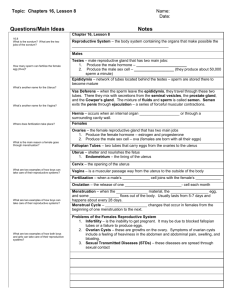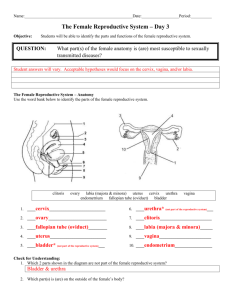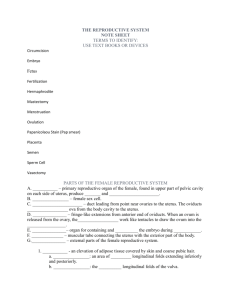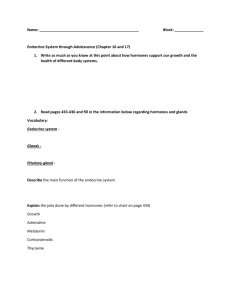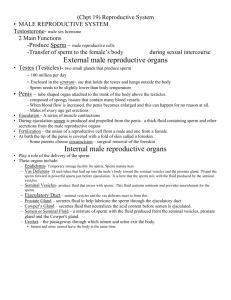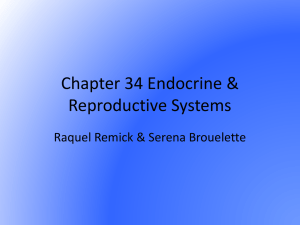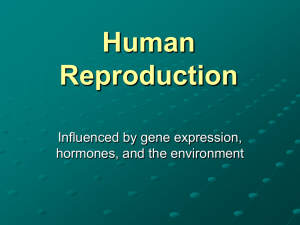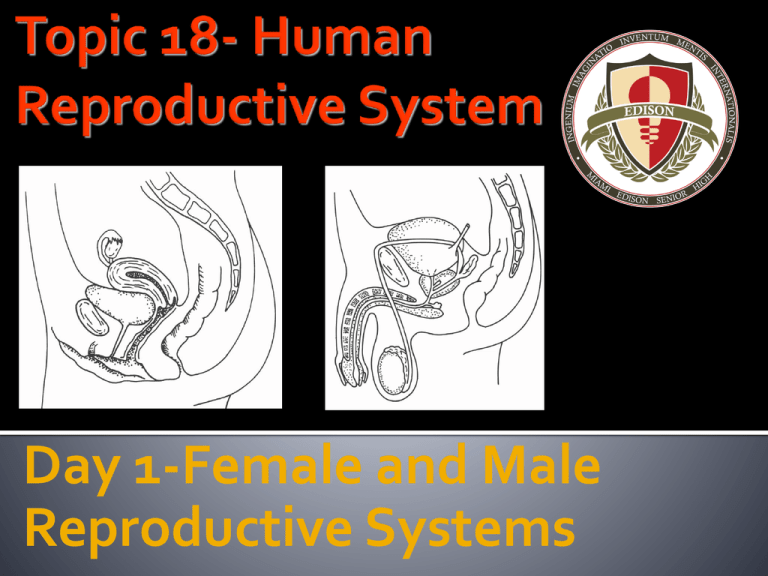
Day 1-Female and Male
Reproductive Systems
1.
2.
3.
4.
5.
Grab a Biology EOC
Exam Preparation
Bell Ringer
Provide a GIST of the
Question.
Bubble your answer.
Explain your answer.
After correcting,
reflect on your
answer.
BENCHMARK
SC.912.L.16.13*Describe the basic
anatomy and
physiology of the
human reproductive
system.
OBJECTIVE
I will Identify and
describe the basic
anatomy and
physiology of the
human reproductive
system.
Human reproductive systems are
essential for human life.
Identify and describe the basic anatomy
and physiology of the human
reproductive system.
Using your Power Notes,
view the posters in the
Gallery Walk to copy in
your notes.
2. Once finished, quietly
return to your seat.
3. We will review these
notes.
1.
What is reproduction?
What is the result of not
being able to reproduce?
What are the reproductive
structures of humans
called?
What is fertilization?
The organs of the female reproductive
system are specialized for three major
functions:
1. To enable sperm to enter the body, to meet with
the ova and create a fetus.
2. The location where a baby develops.
3. To protect the internal genital organs from
infectious organisms.
The female reproductive
system produces ova, a
reproductive cell, or
gamete.
The ova is are produced by
female gonads (sexual
glands) called ovaries. All of
them are present at birth.
In a woman's body the fallopian tube allows passage
of the egg from the ovary to the uterus.
The uterus, or womb, is a
major female hormoneresponsive reproductive
sex organ.
In the uterus, the fetus develops during gestation.
One end, the cervix, opens into the vagina, while the
other is connected to one or both fallopian tubes.
The cervix is the lower, narrow portion of the uterus
where it joins with the top end of the vagina.
The cervix has an opening to
allow sperm and menstrual
fluid to move through.
The vagina is a sex organ with two
main functions: sexual intercourse and childbirth.
The vagina is a hollow muscular organ that joins the
cervix (the lower part of uterus) to the outside of the
body. The vaginal walls are lined in a mucus
membrane for protection and to keep it moist.
The organs of the male reproductive system
are specialized for three major functions:
1. To produce, maintain and transport sperm (the
male reproductive cells) and protective fluid
(semen)
2. To discharge sperm within the female
reproductive tract.
3. To produce and secrete male sex hormones
Sperm refers to the male
reproductive cells.
The scrotum is a pouch-like
structure that hangs behind the
penis. It holds and protects the
testes. It also contains numerous
nerves and blood vessels.
The testies are the male gonads.
They produce sperm and
hormones, mainly testosterone.
The epididymis is a whitish mass of tightly coiled
tubes cupped against the testicles. It acts as a
maturation and storage place for sperm before
they pass into the vas deferens, tubes that carry
sperm to the ampullary gland and prostatic
ducts.
The vas deferens, also known as the sperm duct,
is a thin tube that starts from the epididymis to
the pelvic cavity.
Seminal vesicles are sac-like structures attached
to the vas deferens at one side of the bladder.
They produce a sticky, yellowish fluid. This fluid
provides sperm cells energy.
The urethra is a tube that connects the urinary
bladder to the genitals for the removal of fluids
from the body. In males, the urethra travels
through the penis, and carries semen as well as
urine.
The prostate gland surrounds the
ejaculatory ducts at the base of
the urethra, just below the
bladder. The prostate gland is
responsible for the production of
semen, a liquid mixture of sperm
cells, prostate fluid and seminal
fluid.
The penis is the male sex organ. It
releases the sperm from the
body.
Get a Reinforcement Worksheet.
Read the paragraph summary and
answer questions 1-4.
3. File your student work in your
student folder.
4. Comment on at least 4
assignments.
1.
2.


